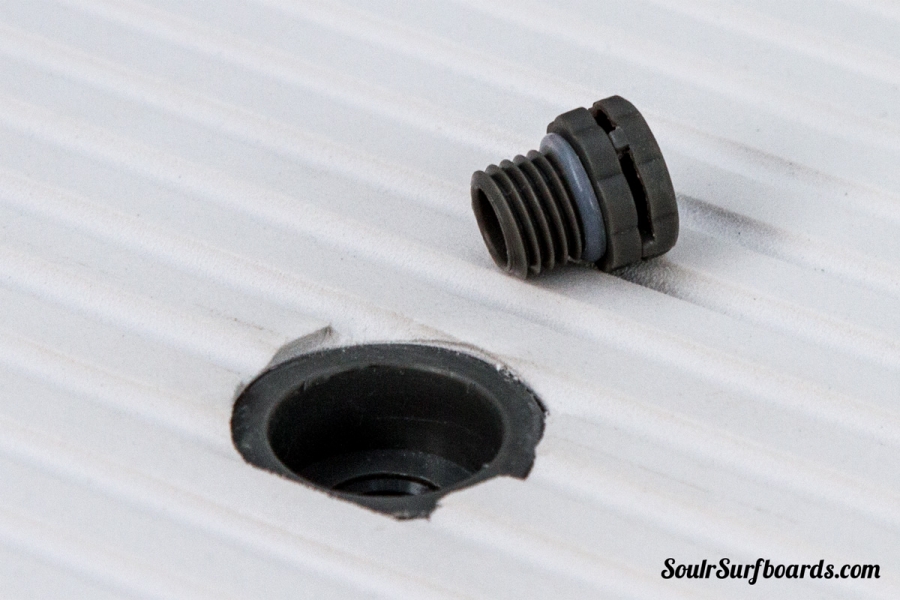Nearly all modern stand up paddle boards have an air vent installed on the deck. Air vents are used as a way to help prevent delamination of the epoxy resin from the EPS foam blank. When delamination occurs, it creates huge air bubbles underneath the shell. This causes the shell to become brittle and can crack when stepped on. Delamination happens when pressure builds up inside the board. Primarily, the pressure build up is caused by two things: heat and altitude changes.
Delamination by Heat
Nearly all stand up paddle boards use EPS foam cores because the material is lightweight and reasonably easy to shape. But when EPS heats up, it can become unstable and expand, causing delamination. Your SUP can warm up quickly when not in the water. Leaving a SUP exposed on the beach or shore, without a bag covering it, can cause a board to delaminate. An air vent helps prevent delamination by allowing some of the expanded gases to equalize, but it is not a cure. If you are not using your stand up paddle board, you want to keep it in the shade or secure it in a reflective board bag.
Delamination by Altitude
Changes in altitude are the other main cause of delamination. This can happen when traveling in the mountains, long road trips or plane flights. As the atmospheric pressure is decreased (or increased), it creates a pressure differential between your SUP and the atmosphere. A vent will allow the pressure to equalize, saving your board from delamination.
Types of SUP Air Vents
Now you know why a stand up paddle board requires an air vent. But interestingly enough, not all air vents are created equal. There are primarily two types of air vents used in SUPs: screw-type and “hassle free” auto-vent plugs.
Screw-type air vents are simple: a threaded stainless steel base is sealed into the deck of the SUP, and a screw is threaded through it. Typically, you need to unscrew the plug when the SUP is not in use, and you need to screw the plug tight before taking it in the water. Sounds simple enough, but it does complicate things. You’ll always need to bring an allen key to screw the plug tight. You’ll also need to remember to close the plug before getting in the water. Leaving it open will let water get inside your SUP, which can cause a whole other set of issues. We at Soulr used these screw-type vents in our prototype boards and quickly decided to go a different route.
 Hassle free air vents are exactly as they sound, hassle free. These vents use a high-tech membrane that allows air pressure to equalize, but keeps water from entering the board. Once the air vent is installed, you don’t really need to touch it again. You just need to make sure it stays hand-tight. The one exception is if you decide to take the SUP on an airplane, it’s a good idea to remove the hassle free air vent because of the dramatic changes in air pressure. For these reasons, all Soulr SUPs feature a hassle-free air vent. It’s one less thing to remember, which makes paddle boarding more fun.
Hassle free air vents are exactly as they sound, hassle free. These vents use a high-tech membrane that allows air pressure to equalize, but keeps water from entering the board. Once the air vent is installed, you don’t really need to touch it again. You just need to make sure it stays hand-tight. The one exception is if you decide to take the SUP on an airplane, it’s a good idea to remove the hassle free air vent because of the dramatic changes in air pressure. For these reasons, all Soulr SUPs feature a hassle-free air vent. It’s one less thing to remember, which makes paddle boarding more fun.
Do EPS Surfboards have Air Vents?
That's a great question. If an epoxy surfboard shares similar construction to an epoxy SUP, shouldn't they have an air vent too? The short answer is no. While an epoxy surfboard can delaminate under high-levels of heat, the amount of EPS foam in a surfboard is a LOT less than a stand up paddle board. Compared to a SUP, an epoxy surfboard is far less prone to delaminating due to heat. And unless you're hiking the himalayas, they should never delaminate due to changes in altitude. There is simply not enough volume inside the board to overcome the strength of the epoxy resins.
